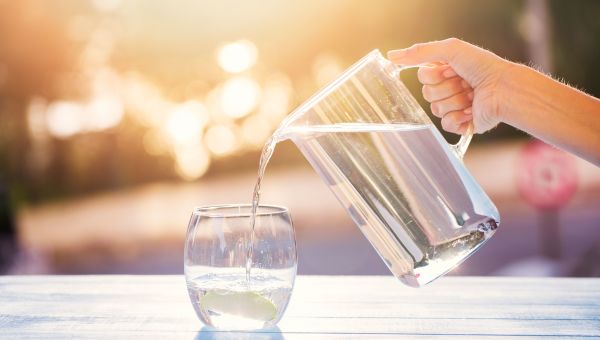6 tips for healthy eating with chronic lymphocytic leukemia
Healthy eating and boosting your calorie intake can help support your treatment.
Updated on April 4, 2024

When you have chronic lymphocytic leukemia (CLL)—a type of blood cancer that starts from cells in the bone marrow and affects white blood cells that are part of the immune system—your food choices may help improve your body's own defenses and support your treatment. It may help to focus on two key areas: eating enough and eating safely.
Eating enough can become a… Show More
When you have chronic lymphocytic leukemia (CLL)—a type of blood cancer that starts from cells in the bone marrow and affects white blood cells that are part of the immune system—your food choices may help improve your body's own defenses and support your treatment. It may help to focus on two key areas: eating enough and eating safely.
Eating enough can become a challenge when the side effects of treatment—or from the cancer itself—decrease your appetite. During treatment your sense of taste can change, which may make even your favorite foods less appetizing. Or you might experience nausea that makes eating difficult. Although both issues may resolve with time, maintaining your weight when you have nausea or loss of taste can be a challenge and may require some intentional eating.
Food safety is always important but becomes even more so when your immune system is weakened due to cancer and cancer treatment. That’s why you should avoid some foods entirely and be careful when preparing others. When eating in restaurants, you'll need to be even more cautious about which foods you choose. Here are a few more essentials to keep in mind.
Show Less
Eat small but often
When you’re having treatment for CLL or feeling unwell, getting enough calories can be difficult. But it’s vital to maintain your calorie intake as much as you can. It can help keep your energy levels up and avoid losing too much weight. Eating smaller, more frequent meals and high-calorie… Show More
When you’re having treatment for CLL or feeling unwell, getting enough calories can be difficult. But it’s vital to maintain your calorie intake as much as you can. It can help keep your energy levels up and avoid losing too much weight. Eating smaller, more frequent meals and high-calorie snacks throughout the day (rather than trying to eat three big meals) can help.
This strategy can also help when you’re dealing with changes in taste along with a reduced appetite. Discussing your options with a dietitian may also help you select options that work best for you. For further questions about nutrition and cancer and how your insurance may cover, speak with your healthcare provider.
Show Less
Handle raw foods with care
Raw fruits and vegetables require thorough washing. Other foods to be careful about include raw honey, shellfish, raw fish (as in sushi, sashimi, or ceviche), uncooked tofu, and raw vegetable sprouts or alfalfa. These types of foods may contain germs that can be dangerous for people with cancer or… Show More
Raw fruits and vegetables require thorough washing. Other foods to be careful about include raw honey, shellfish, raw fish (as in sushi, sashimi, or ceviche), uncooked tofu, and raw vegetable sprouts or alfalfa. These types of foods may contain germs that can be dangerous for people with cancer or for those undergoing cancer treatment. Like dairy products, fruit juices should be pasteurized.
Another concern with raw foods, especially meats, is cross-contamination. Washing hands thoroughly after handling raw meat, using different preparation tools for raw meats and other foods, and storing raw foods separately from ready-to-eat foods can all help reduce the chance of transmitting harmful germs.
Meats require thorough cooking. Beef, lamb and pork should be cooked to an internal temperature of 160°F; chicken and other poultry like turkey to 165°F. A digital or meat thermometer can help you measure temperature in the thickest part of the meat. Heat casseroles to 165°F and warm processed meats like hot dogs and lunch meats until they’re steaming. Any leftovers should be refrigerated promptly.
Show Less
Boost calories with add-ons
You can get extra calories into your daily diet by mixing protein powders or supplements into yogurt, shakes or smoothies. For recipes that include milk, try substituting whole milk or half-and-half. Having a milkshake between meals can also increase your calories, as can adding butter, cheese or… Show More
You can get extra calories into your daily diet by mixing protein powders or supplements into yogurt, shakes or smoothies. For recipes that include milk, try substituting whole milk or half-and-half. Having a milkshake between meals can also increase your calories, as can adding butter, cheese or cream sauces to meals.
You can also increase your calories in healthy snacks by adding dried fruits or roasted nuts or by stirring in or slathering on nut butters (like peanut, almond or cashew). Supplemental nutrition drinks or bars may also be helpful.
Before taking any of these steps, of course, consult with a dietitian or your healthcare provider. Depending on your situation, your healthcare provider may also recommend taking vitamins.
Show Less
Cook eggs completely for safety
Packed with nutrition, eggs can be a great way to add fat, protein and calories to your day. But they also can be carriers of Salmonella, a type of bacteria that affects the digestive tract and can cause significant illness. To decrease the chances of catching Salmonella, so be sure to cook… Show More
Packed with nutrition, eggs can be a great way to add fat, protein and calories to your day. But they also can be carriers of Salmonella, a type of bacteria that affects the digestive tract and can cause significant illness. To decrease the chances of catching Salmonella, so be sure to cook both white and yolk until solid, not runny.
It’s also wise to avoid foods that may contain raw eggs, such as hollandaise sauce. Raw eggs may also be found in unexpected places, including cheesecake, homemade mayonnaise and some Caesar salad dressings. In fact, when it comes to dressings, it’s best to avoid the options found in grocery store refrigerators and use bottled varieties found on shelves in the grocery aisles.
Show Less
Manage liquids carefully
Drinking a lot of fluids before eating can fill you up quickly, so it’s a good idea to limit your liquid intake before meals.
But don’t restrict your overall fluid intake between meals, however. It’s important to stay hydrated throughout the day. Aim for at least eight 8-ounce glasses of… Show More
Drinking a lot of fluids before eating can fill you up quickly, so it’s a good idea to limit your liquid intake before meals.
But don’t restrict your overall fluid intake between meals, however. It’s important to stay hydrated throughout the day. Aim for at least eight 8-ounce glasses of fluid per day. Fruit juices count, too, as long as they’re pasteurized, and they can also provide extra calories that you might need.
Show Less
Choose only pasteurized dairy foods
As with eggs, soft cheeses and unpasteurized dairy products may carry bacteria that can cause illness. Check for the word “pasteurized” on all dairy products and avoid blue-veined soft cheeses, such as blue cheese and Stilton, and Latin American-style soft cheeses, such as queso blanco or queso… Show More
As with eggs, soft cheeses and unpasteurized dairy products may carry bacteria that can cause illness. Check for the word “pasteurized” on all dairy products and avoid blue-veined soft cheeses, such as blue cheese and Stilton, and Latin American-style soft cheeses, such as queso blanco or queso fresco.
What cheeses can you eat? Hard cheeses (such as cheddar and Romano) are fine, as are pasteurized cottage cheese or mozzarella and any pasteurized cheese spreads. As long as it’s safely pasteurized, cheese can be a good way to increase calories when added to meals and snacks, whether melted over meats or vegetables, or stirred into sauces.
Show LessMore On

article

article

article

article
